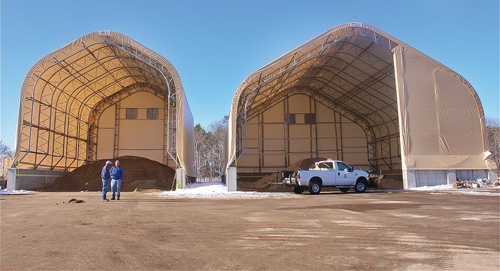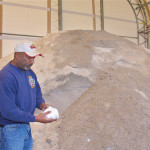Snow keeps coming, but costs haven’t piled up so far

Though the snow keeps on coming this winter, Riverhead’s snow removal budget seems to be weathering the storms so far.
While overtime expenses are harder to pin down — union employees in the highway department have until the end of the year to be either paid in overtime expenses or be reimbursed with comp time — salt and sand costs aren’t breaking the bank. At least at this point.
About 43 inches of snow has been dumped on the area so far this year — well above the norm of about 19 inches through February. About $80,000 of the $175,000 devoted to salt and sand costs has been spent and about another $40,000 in orders have been placed but not yet paid out.
“We’re usually pretty tight on the budgets,” said Highway Superintendent George “Gio” Woodson.
This year, as in the past four years, the highway department has budgeted a total of $275,000 for snow removal out of its $7 million budget: $175,000 for “contractual expenses,” meaning salt and sand, plus $100,000 for employee overtime. The town exceeded its snow removal budget during the 2010-11 winter, when more than 50 inches of snow fell. That year, nearly twice the amount budgeted for overtime and $20,000 more in salt and sand was spent.
Over the past two years, expenses have come in well below the town’s snow removal budget: $76,316 last year and more than $160,000 in 2012.
In a typical winter, the town will run through 3,000 to 3,200 tons of salt and sand. So far this year, Mr. Woodson estimated that he’s already used roughly 1,000 tons, with another 700 tons on order.

2014 has turned out to be a strange year so far, in that the town has managed to avoid a blizzard for the record books — unlike last winter, when more than two feet of snow hit the area in one fell swoop. Through the first 12 days of February, the area has seen nearly a foot of snow — just five inches above the norm — but below average temperatures and more sporadic snowfall have resulted in icier roadways than normal. Another four to eight inches of snow could fall Thursday night into Friday .
“Right now, they’re salting and sanding what seems like two times a week, and then they’re out plowing” said Bill Rothaar, the town’s financial administrator.
Mr. Woodson said that since he took office in 2008, the department has transitioned from using about 15 smaller salt trucks to five larger Mack trucks that save on both fuel and personnel costs.
While fuel expenses might not come directly out of the overtime or salt lines in his snow budget, any cost saving is a plus, since overruns would need to be made up elsewhere.
“That’s just two lines of his entire budget,” said Mr. Rothaar. In fact, snow removal accounts for a mere 3.9 percent of Mr. Woodson’s budget.
“So if other lines are unspent, then in that particular year we can take money from that line if other ones are overspent,” Mr. Rothaar said. “And if there is no line to take it from, we would have to take it from the fund balance.”
But both Mr. Rothaar and Mr. Woodson explained that the more likely scenario would be that the highway department would have to pull funds from other highway projects if snow removal ends up running over budget.
“The longer you’re plowing, the less time you have to do paving,” Mr. Rothaar said.
Mr. Woodson echoed that observation.
“It just hurts another part of the budget that we’d need,” he said. “Asphalt, drainage, sidewalks. But I don’t even want to think about that.”
PHOTO CAPTION: BARBARAELLEN KOCH PHOTO | The town typically goes through about 3,000 to 3,200 tons of salt per year.








